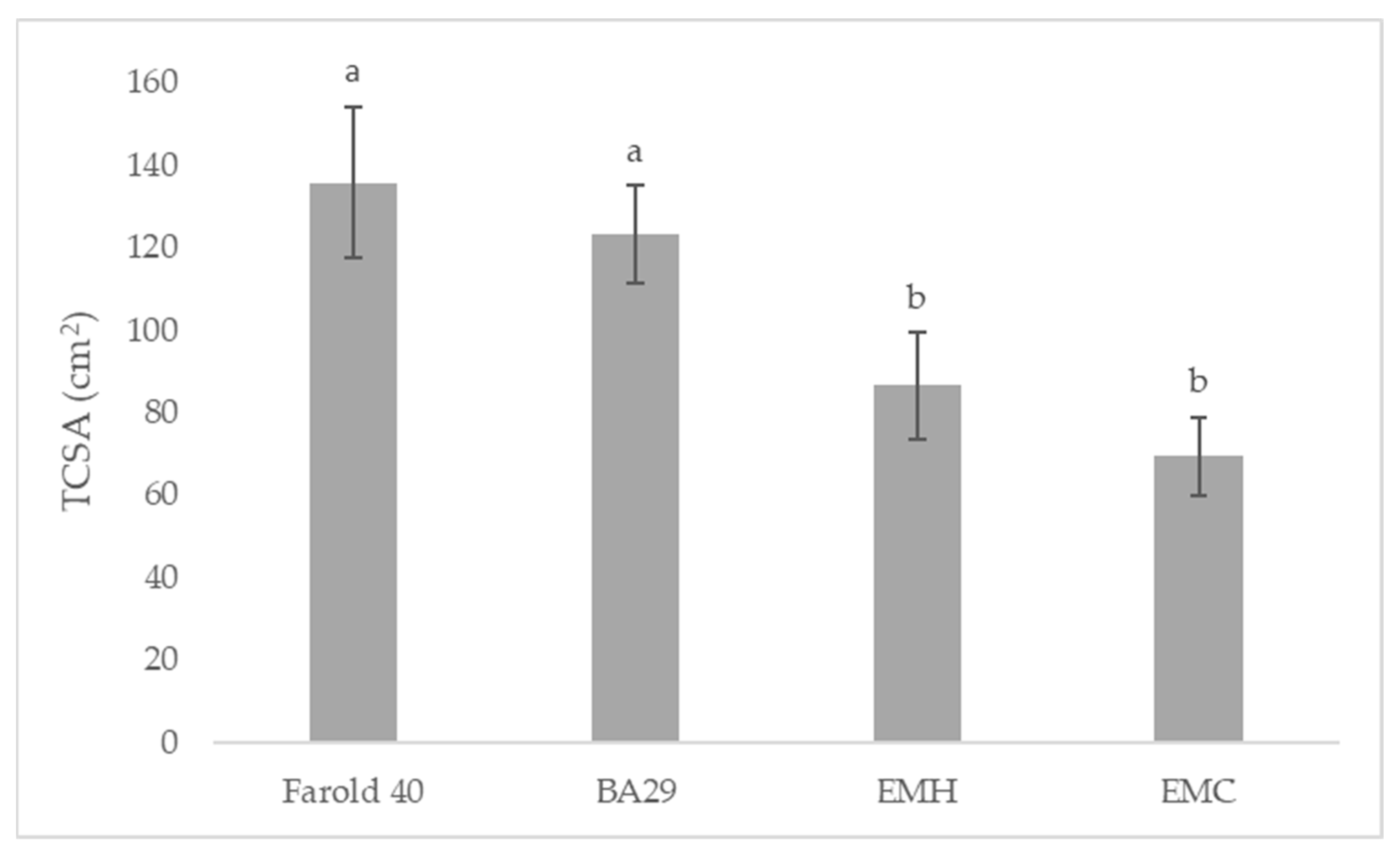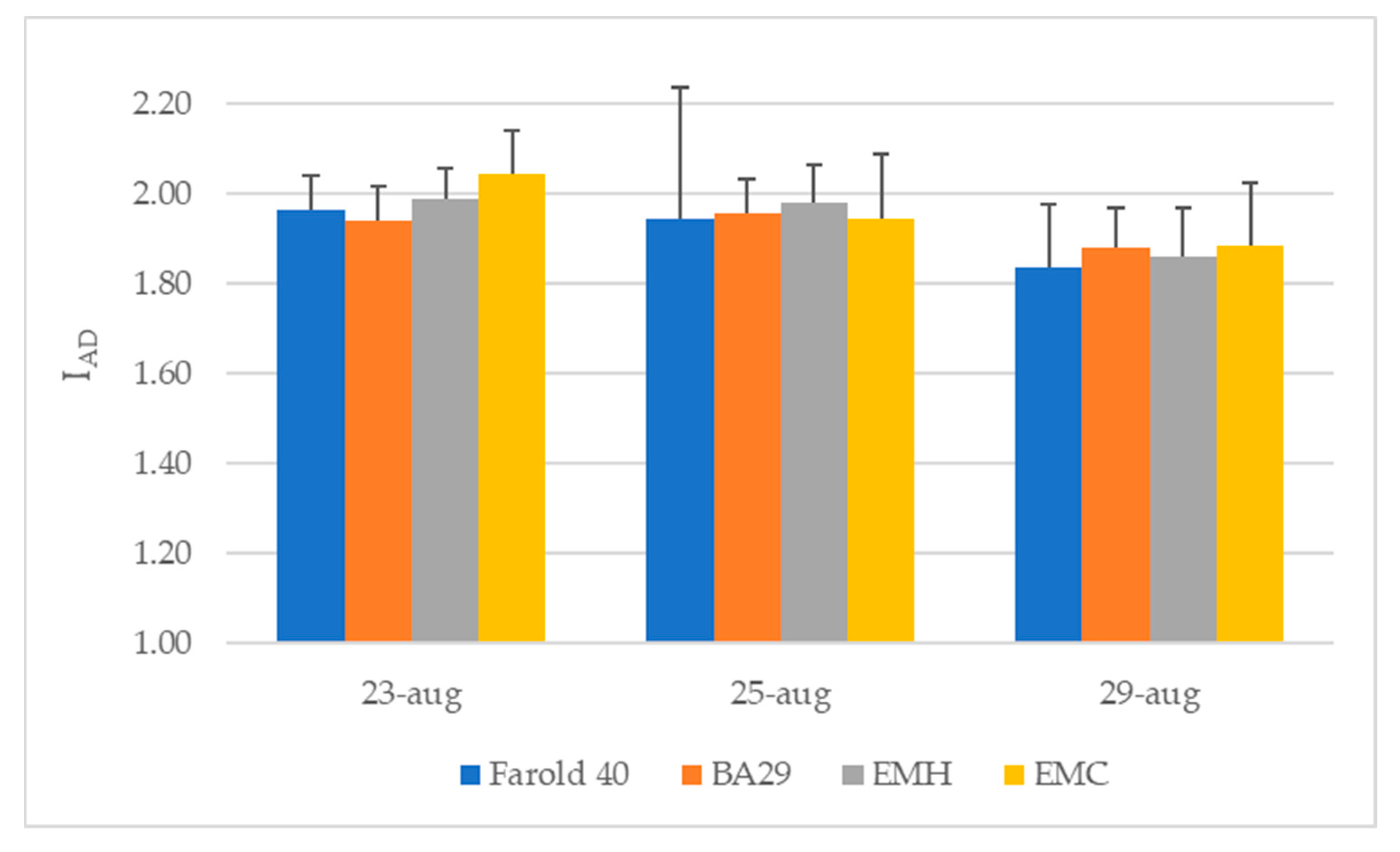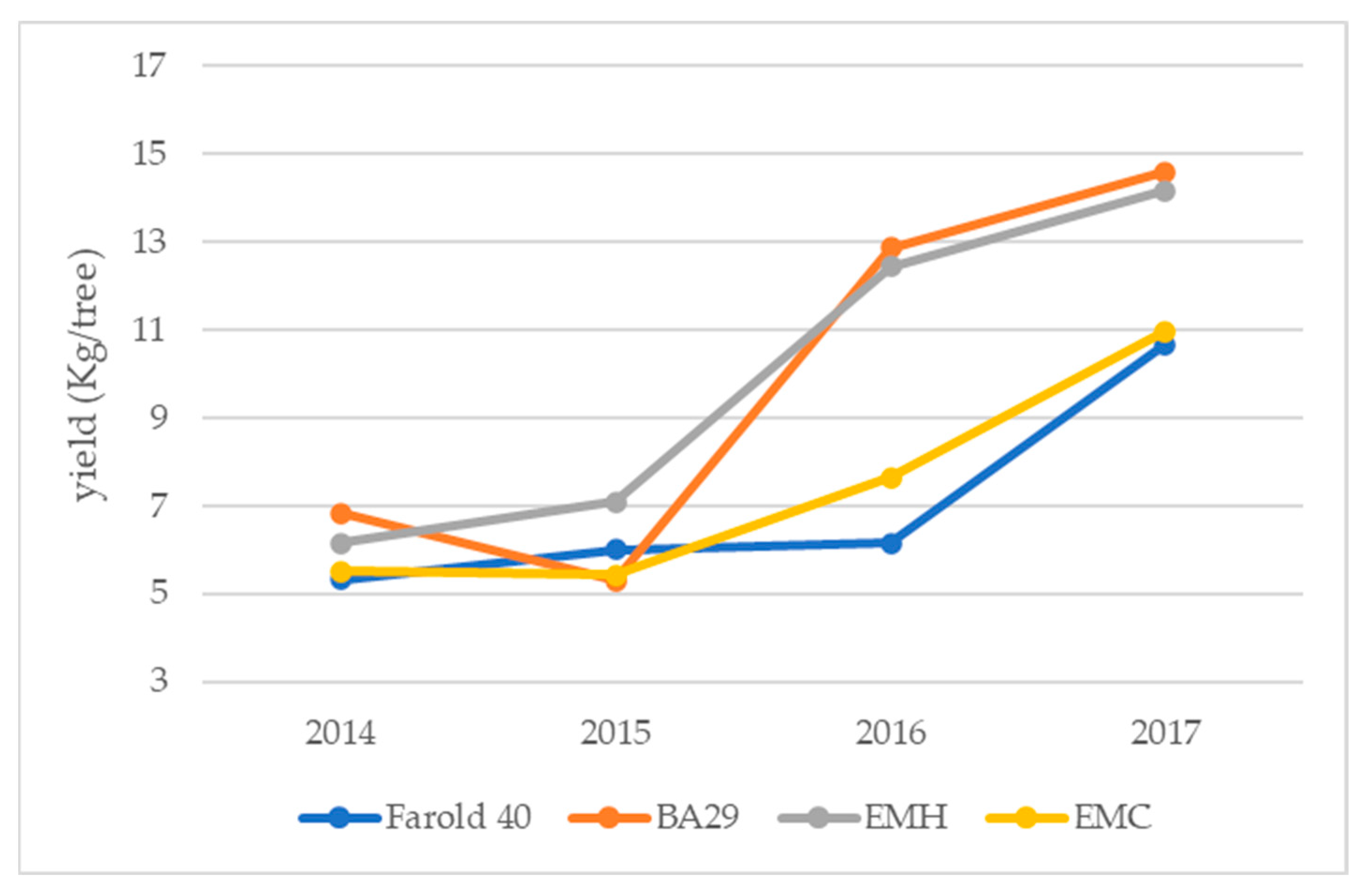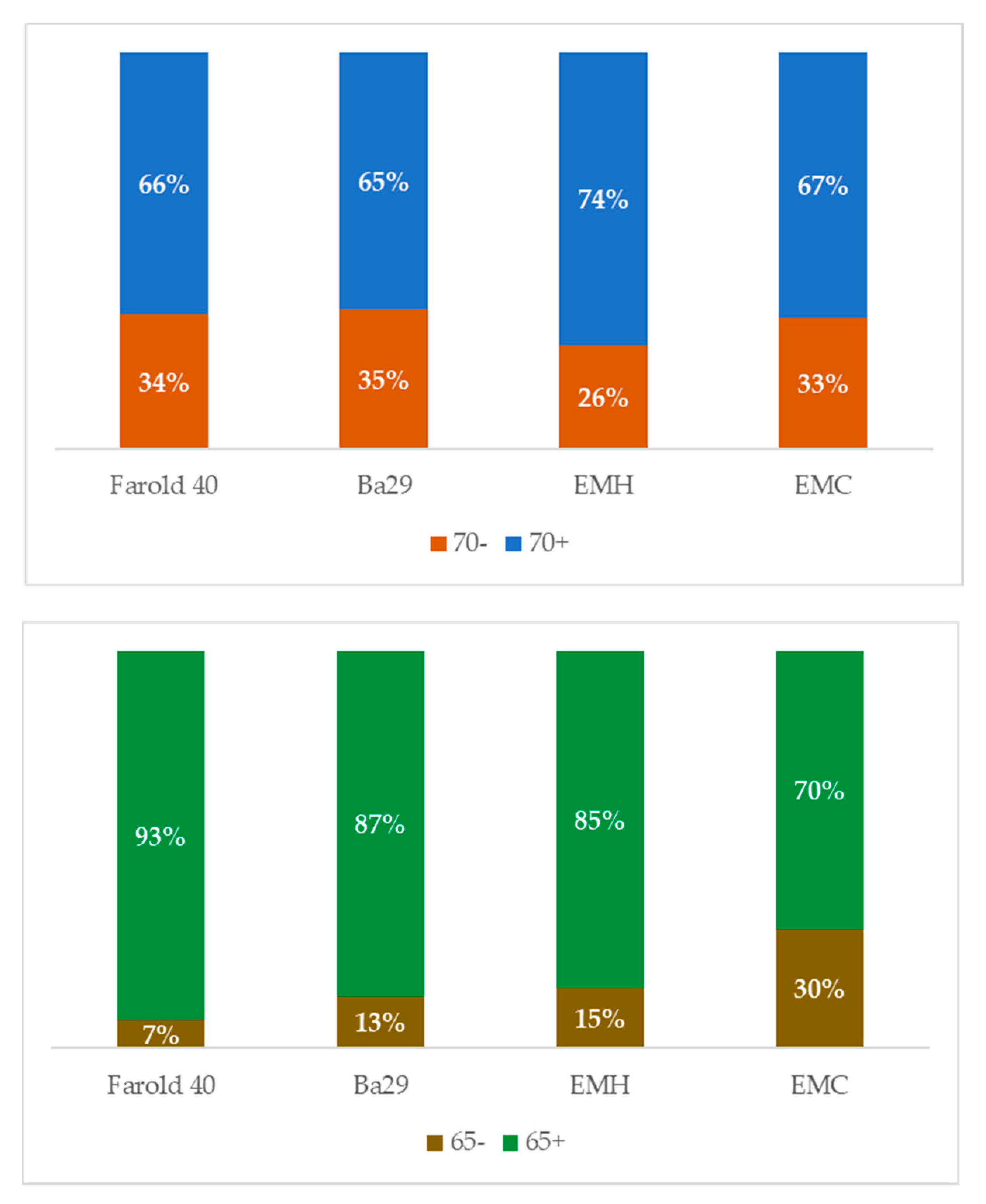Productivity and Fruit Quality of ‘FalstaffPBR’ Pear Variety Grafted on Different Rootstocks
Abstract
1. Introduction
2. Materials and Methods
3. Results
3.1. Plant Phenology and Morphology and Pomological Characteristics
3.2. Production and Fruit Quality at Harvest
4. Discussion
5. Conclusions
- -
- Winter pruning should be carried out in the Fleckinger ‘D or E’ phase (appearance of bunches and green buttons);
- -
- Pruning is completely different on ‘Abbé Fétel’. No shortcuts should be made on branches;
- -
- FalstaffPBR’ has a very assurgent growth habit. In June, if necessary, branches, even if productive, can be thinned at the top of the tree;
- -
- Branches that are too vigorous or aged must be removed;
- -
- Branches that have produced fruit in the distal part may give mixed buds in the proximal part in the following year.
Supplementary Materials
Author Contributions
Funding
Data Availability Statement
Acknowledgments
Conflicts of Interest
References
- Caracciolo, G.; Maltoni, M.L.; Faedi, G.; Sirri, S.; Baruzzi, G. Qualitative and Nutraceutical Characteristics after Storage of New Pear Selections in Emilia-Romagna Region. Agronomy 2021, 11, 2515. [Google Scholar] [CrossRef]
- Caracciolo, G.; Sirri, S.; Baruzzi, G. Update on CREA Centro di Ricerca Olivicoltura, Frutticoltura e Agrumicoltura pear breeding program. Acta Hortic. 2021, 1303, 29–36. [Google Scholar] [CrossRef]
- Pallotti, G.; Baruzzi, G.; Caracciolo, G.; Sirri, S. Nuovo interesse per le pere rosse, prime osservazioni sui cloni del Crea. Frutticoltura 2016, 10, 12–17. [Google Scholar]
- Webster, A.D. Factors influencing the flowering, fruit set and fruit growth of European pears. Acta Hortic. 2002, 596, 699–709. [Google Scholar] [CrossRef]
- Stassen, P.J.C.; North, M.S. Nutrient distribution and requirement of ‘Forelle’ pear trees on two rootstocks. Acta Hortic. 2005, 671, 493–500. [Google Scholar] [CrossRef]
- Tagliavini, M.; Bassi, D.; Marangoni, B. Growth and mineral nutrition of pear rootstocks in lime soil. Sci. Hortic. 1993, 54, 13–22. [Google Scholar] [CrossRef]
- Bosa, K.; Jadczuk-Tobjasz, E.; Kalaji, M.; Majewska, M.; Allakhverdiev, S.I. Evaluating the effect of rootstocks and potassium level on photosynthetic productivity and yield of pear trees. Russ. J. Plant Physiol. 2014, 61, 231–237. [Google Scholar] [CrossRef]
- Jacobs, J.N.; Cook, N.C. The effect of rootstock cultivar on the yield and fruit quality of ‘Packham’s Triumph’, ‘Doyenne du Comice’, ‘Forelle’, ‘Flamingo’ and ‘Rosemarie’ pears. S. Afr. J. Plant Soil 2003, 20, 25–30. [Google Scholar] [CrossRef]
- Maas, F. Evaluation of yield efficiency and winter hardness of quince rootstock for “Conference” pear. Acta Hortic. 2014, 1094, 93–101. [Google Scholar]
- Lewko, J.; Scibisz, K.; Sadowski, A. Performance of two pear cultivars on six different rootstocks in the nursery. Acta Hortic. 2007, 732, 227–231. [Google Scholar] [CrossRef]
- Sugar, D.; Basile, S.R. Performance of ‘Comice’ pear on quince rootstocks in Oregon, USA. Acta Hortic 2011, 909, 215–218. [Google Scholar] [CrossRef]
- Loreti, F.; Massai, R.; Fei, C.; Cinelli, F. Performance of ‘Conference’ cultivar on several quince and pear rootstocks: Preliminary results. Acta Hortic. 2002, 596, 311–318. [Google Scholar] [CrossRef]
- Haak, E.; Kviklys, D.; Lepsis, J. Comparison of Cydonia and Pyrus rootstocks in Estonia, Latvia and Lithuania. Sodinink. Ir. Darzinink. 2006, 25, 322–326. [Google Scholar]
- Sotiropoulos, T.E. Performance of the pear (Pyrus communis) cultivar ‘William’s Bon Chretien’ grafted on seven rootstocks. Aust. J. Exp. Agric. 2006, 46, 701–705. [Google Scholar] [CrossRef]
- Kappel, F.; Fisher-Fleming, R.; Hogue, E.J. Ideal Pear Sensory Attributes and Fruit Characteristics. Hortscience 1995, 30, 988–993. [Google Scholar] [CrossRef]
- Bell, R.L.; Quamme, H.A.; Layne, R.E.C.; Skirvin, R.M. Pears. In Fruit Breeding, Volume I: Tree and Tropical Fruits; Janick, J., Moore, J.N., Eds.; Wiley Science: New York, NY, USA, 1996; pp. 441–514. [Google Scholar]
- Quartieri, M.; Marangoni, B.; Schiavon, L.; Tagliavini, M.; Bassi, D.; Previati, A.; Giannini, M. Evaluation of pear rootstock selections. Acta Hortic. 2011, 909, 153–159. [Google Scholar] [CrossRef]
- Wertheim, S.J. Rootstocks for european pear: A review. Acta Hortic. 2002, 596, 299–309. [Google Scholar] [CrossRef]
- da Silva, G.J.; Villa, F.; Grimaldi, F.; da Silva, P.S.; Welter, J.F. Pear (Pyrus spp.) Breeding. In Advances in Plant Breeding Strategies: Fruits; Al-Khayri, J., Jain, S., Johnson, D., Eds.; Springer: Cham, Switzerland, 2018. [Google Scholar]
- Stern, R.A. Pyrus betulifolia is the best rootstock for the “Coscia” pear in the warm climate of Israel. Acta Hortic. 2008, 800, 631–638. [Google Scholar] [CrossRef]
- Francescatto, P.; Pazzin, D.; Gazolla Neto, A.; Fachinello, J.C.; Giacobbo, C.L. Evaluation of graft compatibility between quince rootstocks and pear scions. Acta Hortic. 2010, 872, 253–260. [Google Scholar] [CrossRef]
- Öztürk, A. The Effects of Different Rootstocks on the Graft Success and Stion Development of Some Pear Cultivars. Int. J. Fruit Sci. 2021, 21, 932–944. [Google Scholar] [CrossRef]
- Ozturk, A.; Faizi, Z.A. Comparative Evaluation of Pear Performances Under High- and Low-Density Planting Systems cv. ‘Santa Maria’. Erwerbs-Obstbau 2023, 65, 667–675. [Google Scholar] [CrossRef]
- Musacchi, S.; Serra, S.; Ancarani, V. Comparison among pear training systems and rootstock for high density planting (HDP) of the cultivar ‘Abbé Fétel’. Acta Hortic. 2011, 909, 251–258. [Google Scholar] [CrossRef]
- Kurt, T.; Öztürk, A.; Faizi, Z.A.; Öztürk, B. Impact of Quince Clonal Rootstocks on Yield and Fruit Quality Characteristics of European Pear (Pyrus communis L.) Cultivars. Erwerbs-Obstbau 2023, 65, 1321–1329. [Google Scholar] [CrossRef]
- Cabrera, D.; Rodríguez, P.; Zoppolo, R. Evaluation of quince and selected ‘Farold®’ pear rootstocks for commercial ‘William’s B.C.’ production in Uruguay. Acta Hortic. 2015, 1094, 159–162. [Google Scholar] [CrossRef]
- Costa, G.; Rocchi, L.; Farneti, B.; Busatto, N.; Spinelli, F.; Vidoni, S. Use of Nondestructive Devices to Support Pre- and Postharvest Fruit Management. Horticulturae 2017, 3, 12. [Google Scholar] [CrossRef]
- Available online: https://www.ecpgr.cgiar.org/fileadmin/bioversity/publications/pdfs/ECPGR_Pyrus_descriptors_Final_27-06-22.pdf (accessed on 24 February 2024).
- Hammer, Ø.; Harper, D.A.T.; Ryan, P.D. Past: Paleontological Statistics Software Package for Education and Data Analysis. Palaeontol. Electron. 2001, 4, 178kb. [Google Scholar]
- Gonçalves, B.; Mountinho-Pereira, J.; Santos, A.; Silva, A.P.; Bacelar, E.; Correia, C.; Rosa, E. Scion–rootstock interaction affects the physiology and fruit quality of sweet cherry. Tree Physiol. 2006, 26, 93–104. [Google Scholar] [CrossRef] [PubMed]
- Gullo, G.; Motisi, A.; Zappia, R.; Dattola, A.; Diamanti, J.; Mezzetti, B. Rootstock and fruit canopy position affect peach [Prunus persica (L.) Batsch] (cv. Rich May) plant productivity and fruit sensorial and nutritional quality. Food Chem. 2014, 153, 234–242. [Google Scholar] [CrossRef]
- López-Ortega, G.; García-Montiel, F.; Bayo-Canha, A.; Frutos-Ruiz, C.; Frutos-Tomás, D. Rootstock effects on the growth, yield and fruit quality of sweet cherry cv. ‘Newstar’ in the growing conditions of the Region of Murcia. Sci. Hortic. 2016, 198, 326–335. [Google Scholar] [CrossRef]
- Lordan, J.; Zazurca, L.; Maldonado, M.; Torguet, L.; Alegre, S.; Miarnau, X. Horticultural performance of ‘Marinada’ and ‘Vairo’ almond cultivars grown on a genetically diverse set of rootstocks. Sci. Hortic. 2019, 256, 108558. [Google Scholar] [CrossRef]
- Valverdi, N.A.; Kalcsits, L. Rootstock affects scion nutrition and fruit quality during establishment and early production of ‘Honeycrisp’ Apple. HortScience 2021, 56, 261–269. [Google Scholar] [CrossRef]
- Morales Alfaro, J.; Bermejo, A.; Navarro, P.; Quiñones, A.; Salvador, A. Effect of Rootstock on Citrus Fruit Quality: A Review. Food Rev. Int. 2023, 39, 2835–2853. [Google Scholar] [CrossRef]
- Habibi, F.; Liu, T.; Folta, K.; Sarkhosh, A. Physiological, biochemical, and molecular aspects of grafting in fruit trees. Hortic. Res. 2022, 9, uhac032. [Google Scholar] [CrossRef]
- Sansavini, S.; Ancarani, V.; Neri, D. Overview of intensive pear culture: Planting density, rootstocks, orchard management, soil-water relations and fruit quality. Acta Hortic. 2008, 800, 35–50. [Google Scholar] [CrossRef]
- Tatari, M.; Rezaei, M.; Ghasemi, A. Quince Rootstocks Affect Some Vegetative and Generative Traits. Int. J. Fruit Sci. 2020, 20, S668–S682. [Google Scholar] [CrossRef]
- Webster, A.D. A brief review of pear rootstock development. Acta Hortic. 1998, 475, 135–142. [Google Scholar] [CrossRef]
- Zarrouk, O.; Testillano, P.S.; Risueno, M.C.; Angeles-Moreno, M.; Gogorcena, W. Changes in cell/tissue organization and peroxidase activity as markers for early detection of graft incompatibility in peach/plum combinations. J. Am. Soc. Hortic. Sci. 2010, 135, 9–17. [Google Scholar] [CrossRef]
- Musacchi, S.; Ancarani, V.; Grandi, M.; Sansavini, S. Comparative field performance of cvs. ‘Sensation Red Bartlett’ and ‘Cascade’ grafted to six quinces and pear clonal seedling rootstocks. Acta Hort. 2002, 596, 385–388. [Google Scholar] [CrossRef]
- Aleksandrova, D.; Dimitrova, N. The reaction of pear cultivars grafted on pear and quince rootstocks after artificial inoculation of Erwinia amylovora. Acta Hortic. 2021, 1327, 321–328. [Google Scholar] [CrossRef]
- Nicolai, B.M.; Beullens, K.; Bobelyn, E.; Peirs, A.; Saeys, W.; Theron, K.I.; Lammertyn, J. Nondestructive measurement of fruit and vegetable quality by means of NIR spectroscopy: A review. Postharvest Biol. Technol. 2007, 46, 99–118. [Google Scholar] [CrossRef]
- Vidoni, S.; Rocchi, L.; Donati, I.; Spinelli, F.; Costa, G. Combined use of Planttoon® and IAD to characterize fruit ripening homogeneity in ‘Abbé Fétel’ pears. Acta Hortic. 2015, 1094, 495–499. [Google Scholar] [CrossRef]
- Costa, G.; Rossi, D.; Tamburini, E.; Donegà, V.; Loberti, R. Innovazioni di processo per una pericoltura di qualità. L’Inf. Agrar. 2013, 36, 44–46. [Google Scholar]
- Musacchi, S.; Serra, S. Apple fruit quality: Overview on pre-harvest factors. Sci. Hortic. 2018, 234, 409–430. [Google Scholar] [CrossRef]
- Ubi, B.E. External stimulation of anthocyanin biosynthesis in apple fruit. Food Agric. Environ. 2004, 2, 65–70. [Google Scholar]
- Chen, Z.; Deng, H.; Xiong, B.; Li, S.; Yang, L.; Yang, Y.; Huang, S.; Tan, L.; Sun, G.; Wang, Z. Rootstock Effects on Anthocyanin Accumulation and Associated Biosynthetic Gene Expression and Enzyme Activity during Fruit Development and Ripening of Blood Oranges. Agriculture 2022, 12, 342. [Google Scholar] [CrossRef]






| Phenological Phase | FalstaffPBR | Abbé Fétel | Diff | ||||||||
|---|---|---|---|---|---|---|---|---|---|---|---|
| 2014 | 2015 | 2016 | 2017 | Mean | 2014 | 2015 | 2016 | 2017 | Mean | ||
| White button | 29-Mar | 05-Apr | 30-Mar | 25-Mar | 30-Mar | 23-Mar | 02-Apr | 27-Mar | 24-Mar | 27-Mar | +3 |
| Full bloom | 03-Apr | 09-Apr | 05-Apr | 01-Apr | 04-Apr | 29-Mar | 05-Apr | 01-Apr | 28-Mar | 31-Mar | +4 |
| Fruit set | 07-Apr | 14-Apr | 08-Apr | 03-Apr | 08-Apr | 03-Apr | 09-Apr | 05-Apr | 02-Apr | 05-Apr | +3 |
| 2014 | 2015 | 2016 | 2017 | sum | |
|---|---|---|---|---|---|
| Farold 40 | 12,752 b | 14,408 b | 13,830 c | 24,008 b | 64,998 |
| BA29 | 16,376 a | 12,687 c | 28,943 a | 32,795 a | 90,801 |
| EMH | 14,398 ab | 17,010 a | 27,962 a | 31,887 a | 91,257 |
| EMC | 13,204 b | 18,589 a | 17,222 b | 24,683 b | 73,698 |
| Rootstock | Caliper | 2014 | 2015 | 2016 | 2017 |
|---|---|---|---|---|---|
| Farold 40 | 70− | 39.1 | 59.5 | 9.1 | 27.5 |
| 70+ | 60.9 | 40.5 | 90.9 | 72.5 | |
| BA29 | 70− | 24.5 | 39.2 | 35.2 | 30.5 |
| 70+ | 75.5 | 60.8 | 64.8 | 69.5 | |
| EMH | 70− | 30.7 | 54.8 | 35.5 | 12.5 |
| 70+ | 69.3 | 45.2 | 64.5 | 87.5 | |
| EMC | 70− | 37.3 | 74.0 | 18.2 | 54.5 |
| 70+ | 62.7 | 26.0 | 81.8 | 45.5 |
| (a) | 2014 | 2015 | 2016 | 2017 |
| Farold 40 | 5.04 ± 0.26 | 4.48 ± 0.56 | 5.15 ± 0.51 | 4.72 ± 0.37 |
| BA29 | 4.98 ± 0.39 | 5.34 ± 0.45 | 5.02 ± 0.69 | 4.81 ± 0.44 |
| EMH | 4.72 ± 0.41 | 5.29 ± 0.51 | 5.14 ± 0.55 | 4.87 ± 0.41 |
| EMC | 4.48 ± 0.35 | 5.08 ± 0.49 | 5.28 ± 0.25 | 4.91 ± 0.26 |
| (b) | 2014 | 2015 | 2016 | 2017 |
| Farold 40 | 13.9 ± 0.4 | 14.9 ± 1.3 | 14.9 ± 0.5 | 15.8 ± 0.5 |
| BA29 | 13.9 ± 0.2 | 16.0 ± 1.0 | 15.3 ± 0.9 | 16.1 ± 0.5 |
| EMH | 14.0 ± 0.4 | 15.3 ± 0.8 | 15.1 ± 0.5 | 15.8 ± 0.6 |
| EMC | 13.9 ± 0.5 | 16.4 ± 1.6 | 15.3 ± 0.4 | 15.8 ± 0.2 |
Disclaimer/Publisher’s Note: The statements, opinions and data contained in all publications are solely those of the individual author(s) and contributor(s) and not of MDPI and/or the editor(s). MDPI and/or the editor(s) disclaim responsibility for any injury to people or property resulting from any ideas, methods, instructions or products referred to in the content. |
© 2024 by the authors. Licensee MDPI, Basel, Switzerland. This article is an open access article distributed under the terms and conditions of the Creative Commons Attribution (CC BY) license (https://creativecommons.org/licenses/by/4.0/).
Share and Cite
Caracciolo, G.; Pietrella, M.; Pallotti, G.; Faedi, G.; Sirri, S.; Baruzzi, G. Productivity and Fruit Quality of ‘FalstaffPBR’ Pear Variety Grafted on Different Rootstocks. Horticulturae 2024, 10, 237. https://doi.org/10.3390/horticulturae10030237
Caracciolo G, Pietrella M, Pallotti G, Faedi G, Sirri S, Baruzzi G. Productivity and Fruit Quality of ‘FalstaffPBR’ Pear Variety Grafted on Different Rootstocks. Horticulturae. 2024; 10(3):237. https://doi.org/10.3390/horticulturae10030237
Chicago/Turabian StyleCaracciolo, Giuseppina, Marco Pietrella, Giuseppe Pallotti, Giulia Faedi, Sandro Sirri, and Gianluca Baruzzi. 2024. "Productivity and Fruit Quality of ‘FalstaffPBR’ Pear Variety Grafted on Different Rootstocks" Horticulturae 10, no. 3: 237. https://doi.org/10.3390/horticulturae10030237
APA StyleCaracciolo, G., Pietrella, M., Pallotti, G., Faedi, G., Sirri, S., & Baruzzi, G. (2024). Productivity and Fruit Quality of ‘FalstaffPBR’ Pear Variety Grafted on Different Rootstocks. Horticulturae, 10(3), 237. https://doi.org/10.3390/horticulturae10030237






